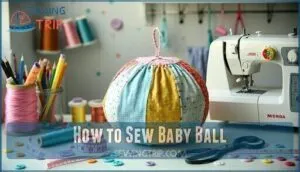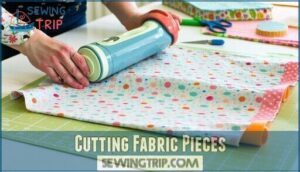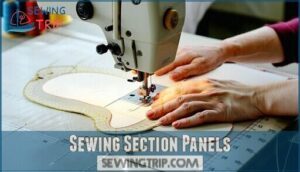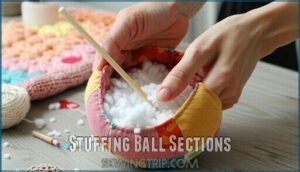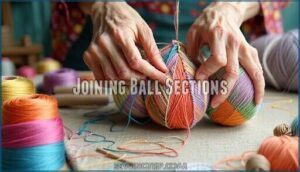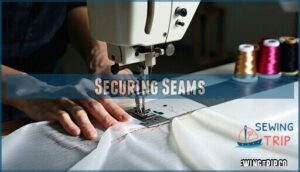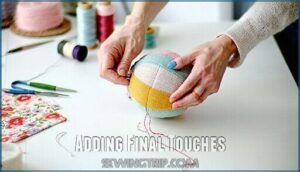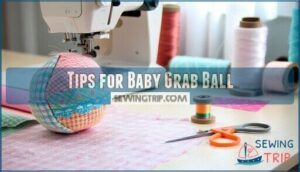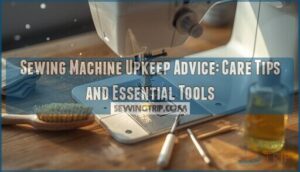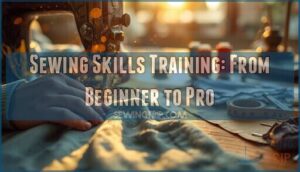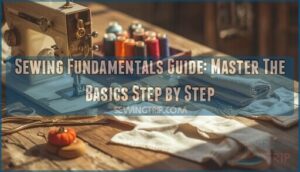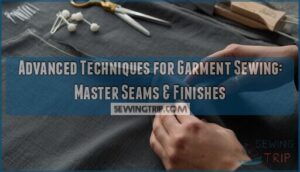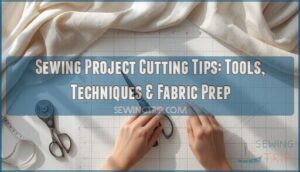This site is supported by our readers. We may earn a commission, at no cost to you, if you purchase through links.
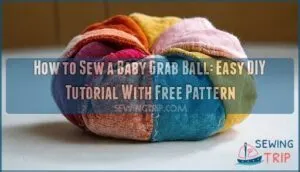
Cut your fabric using a simple pattern, then stitch each piece together with a quarter-inch seam allowance. Leave a small opening for stuffing with polyester fiberfill or cotton batting.
Machine wash your fabrics first to prevent shrinking later. Choose contrasting colors and textures like corduroy, flannel, or cotton to stimulate baby’s senses.
Hand-stitch the final opening closed using a ladder stitch for security. This project takes about two hours and costs under ten dollars.
The real magic happens when you discover which fabric combinations create the most enchanting sensory experience.
Table Of Contents
Key Takeaways
- You’ll need six petal-shaped fabric pieces made from pre-washed cotton, cut with quarter-inch seam allowances, and stuffed with polyester fiberfill to create a safe, durable grab ball that costs under ten dollars.
- Choose contrasting textures like corduroy, flannel, or cotton to stimulate your baby’s senses, and mix high-contrast colors to support developing vision while ensuring fabrics are tightly woven without loose threads.
- Hand-stitch the final opening using a ladder stitch and double-check all seam connections by tugging firmly – they shouldn’t separate since proper reinforcement prevents safety hazards during play.
- Machine wash your finished grab ball weekly on gentle cycle with mild detergent, skip fabric softeners to maintain grip for tiny hands, and inspect seams monthly for wear to keep the toy safe and functional.
Sewing Baby Grab Ball
You’ll create a soft, safe grab ball that helps your baby develop fine motor skills and hand-eye coordination.
This project requires basic sewing skills, cotton fabric pieces, polyester stuffing, and about two hours to complete a finished ball measuring 6-8 inches in diameter, which aids in developing hand-eye coordination.
Choosing Fabric Types
Your fabric choice makes or breaks your fabric ball toy project.
Choose wisely – the right fabric transforms your simple sewing project into a cherished baby keepsake.
Cotton fabric offers the perfect balance of softness and durability for babies.
Consider fabric weight between 4-6 ounces for ideal handling.
Test colorfastness before cutting to prevent bleeding.
Mix textures for sensory development – smooth cottons with subtle patterns work beautifully.
Organic options provide extra peace of mind for sensitive skin.
For warmer climates, consider bamboo fabric options due to its breathability.
Preparing Sewing Materials
Once you’ve selected your cotton fabric, gather your sewing arsenal. Sharp sewing scissors make clean cuts while a washable marker helps trace patterns accurately.
This fabric scraps project needs quality thread that matches your material. Measuring tools guarantee proper fit.
Essential supplies include:
- Sharp needle suitable for cotton fabric
- Fabric pre-washing completed and dried
- Straight pins for securing pieces
- Polyester fiberfill for stuffing
Understanding Pattern Requirements
With your sewing pattern downloaded, check that each piece matches the template consistency requirements.
The baby grab ball pattern needs precise seam allowances – typically 1/4 to 3/8 inch.
Pay attention to fabric grain direction when cutting, as pattern accuracy determines your finished toy’s shape, so don’t rush this step.
Scale patterns correctly if adjusting size for different ages, ensuring that pattern accuracy is maintained to achieve the desired shape.
How to Sew Baby Ball
Now you’re ready to bring your handmade baby toy vision to life. Creating a baby grab ball combines practical sewing skills with thoughtful design choices that’ll make any little one giggle with delight.
This sewing project serves as the perfect baby gift idea when you want something truly special.
Your baby toy pattern success depends on understanding these key elements:
- Ball Size – Aim for 4-6 inches diameter so tiny hands can grasp easily
- Fabric Weight – Choose 4-6 ounce cotton for durability without bulk
- Stitch Types – Use straight stitches with 2.5-3mm length for strong seams
- Stuffing Alternatives – Polyester fiberfill works best, but cotton batting adds natural feel
- Sensory Additions – Include different textures like satin ribbons or crinkly materials
Think of this baby grab ball as your canvas for creativity. Each decision you make affects how your finished toy feels, looks, and performs in those precious little hands.
Creating Ball Sections
You’ll cut 12 fabric pieces using your pattern and sew them into individual sections that form the grab ball’s structure.
Each section requires careful stitching along curved edges with a 1/4-inch seam allowance, then stuffing with polyester fiberfill before closing the seams completely.
The process involves polyester fiberfill to ensure the grab ball is properly filled before the seams are closed.
Cutting Fabric Pieces
Place your pattern pieces on cotton fabrics, aligning with the fabric grain for stability.
Use pattern weights to secure templates on cutting mats.
A rotary cutter creates clean edges better than scissors.
Many sewers find rotary cutters useful for this task.
Mark your seam allowance clearly on each piece.
You’ll need twelve identical pieces for your baby toy – precision here prevents headaches during sewing machine assembly.
| Cutting Tool | Best For |
|---|---|
| Rotary cutter | Clean, precise edges |
| Fabric scissors | Detailed curves |
| Pattern weights | Securing templates |
| Cutting mats | Protecting surfaces |
Sewing Section Panels
Mastering curved seams transforms your fabric ball from amateur to professional.
Pin each panel with right sides together, maintaining proper fabric tension throughout.
Set your stitch length to 2.5mm for durability and sew slowly around curves.
Focus on panel alignment—mismatched edges create lumpy results.
Add seam reinforcement at stress points by backstitching twice.
To prevent fraying, consider using overlock stitches quickly on the raw edges.
This sewing tutorial step guarantees your fabric sewing project withstands enthusiastic baby play.
Stuffing Ball Sections
Your fabric ball takes shape once you pack it properly.
Choose polyester fiberfill for your DIY baby toy – it’s washable and hypoallergenic. Fill each section about 75% full, using your fingertips for even distribution.
Don’t overstuff your soft baby ball or it’ll lose flexibility. Push toy stuffing into corners with a chopstick, making certain consistent stuffing density throughout your sewing tutorial project.
For maximum safety, make certain you use strong, secure stitches during assembly.
Assembling The Grab Ball
Now you’ll connect your stuffed sections to create the finished grab ball.
Start by joining three sections at their pointed tips to form a triangle, then connect the remaining sections until you have a complete sphere.
Joining Ball Sections
Once you’ve prepared your stuffed sections, it’s time to bring your fabric ball to life through careful panel alignment and strategic section connections.
Follow these essential stitching techniques for ideal ball construction:
- Align three sections at their pointed tips using precise hand stitches
- Connect bottom edges where all three sections meet at center point
- Repeat grouping process to form four triangular segments total
- Join segments together using consistent seam reinforcement methods
For durable seams, consider using the full backstitch technique.
Securing Seams
Now that you’ve connected all sections, reinforcement stitching becomes your safety net.
Check each stress point where panels meet and backstitch twice for extra strength. Adjust your thread tension to prevent puckering while maintaining a 2.5mm stitch length.
These seam finishes protect against wear from little hands. This fabric ball tutorial emphasizes durability—baby sewing projects need rock-solid construction for safe play.
Adding Final Touches
Once your seams are locked in place, you’re ready to polish your fabric ball masterpiece. These finishing touches transform a simple toy into something special for little hands.
Here’s how to add those perfect final details:
- Seam Reinforcement – Double-check all connection points and add extra stitches where needed
- Stitch Concealment – Hide any visible thread ends with a secure knot tucked inside
- Embellishment Options – Consider adding soft ribbons or contrasting fabric patches
- Fabric Protection – Apply fabric protector spray for easier cleaning and maintenance
Your personalization ideas can include embroidered names or colorful appliqués. Follow these sewing tips to guarantee your stuffing stays put and seams remain strong through countless play sessions.
Tips for Baby Grab Ball
Your finished baby grab ball needs proper care and smart choices to stay safe and functional for your little one.
These essential tips will help you select the right fabrics, maintain the ball’s condition, and guarantee it meets safety standards for infant play, which involves making smart choices.
Ensuring Baby Safety
Check your fabric safety by selecting tightly woven cotton without loose threads.
Test stitch security by tugging seams firmly – they shouldn’t separate.
Keep toy size under four inches diameter to prevent suffocation hazards.
Double-stitch all connections for babysafe toy construction.
Follow wash instructions using gentle, fragrance-free detergent.
Your infant toy needs regular inspection for wear, ensuring newborn toy safety through proper baby toy design.
Always unplug the machine when changing the feet.
Customizing Fabric Choices
Mix fabric textures like smooth cotton with bumpy corduroy to create a sensory baby toy that stimulates touch.
Choose color palettes with high contrast – bright yellows against deep blues help developing vision.
Pattern mixing works well when you combine polka dots with stripes.
Consider fabric weight carefully; lightweight materials make your fabric ball easier for tiny hands to grasp and manipulate during play with high contrast colors.
Maintaining The Grab Ball
Your DIY baby toy needs regular care to stay safe and soft. Machine wash your fabric ball on gentle cycle with mild detergent.
Skip fabric softeners – they reduce grip for tiny hands. For stain removal, spot clean immediately with baby-safe soap.
Store your plush baby ball in a clean, dry place. Check seams monthly for wear and repair loose stitching promptly to keep this sensory baby toy secure.
Frequently Asked Questions (FAQs)
How do you personalize a fabric ball for a baby?
What touches the heart more than a gift made just for them?
You’ll personalize your fabric ball by adding embroidered names, choosing meaningful fabric patterns, or incorporating family photos printed on fabric transfers for lasting memories.
This approach allows for a personalized and meaningful gift.
How do you make a soft baby ball?
Cut twelve fabric pieces using a ball pattern, then sew them together with right sides facing.
Leave an opening, turn inside out, stuff firmly with polyester fiberfill, and hand-stitch closed securely.
How do you make a baby ball fun?
Add colorful fabric scraps, different textures like minky or corduroy, and small ribbon loops.
Include crinkly material inside some sections.
Use high-contrast patterns to stimulate baby’s vision and create varied tactile experiences.
Can the baby grab ball be machine washed?
Yes, you can machine wash your baby grab ball safely.
Use gentle cycle with cold water and mild detergent.
Choose machine-washable fabrics like cotton or flannel when constructing to guarantee easy maintenance and hygiene.
What age is appropriate for grab balls?
Like tiny explorers discovering treasure, babies can safely enjoy grab balls from 3-6 months old.
You’ll find they’re perfect when your little one starts reaching and grasping.
These developmental toys grow with them through their first year, making them a great choice for little ones.
How long does the project typically take?
You’ll need about 2-3 hours to complete this weekend project. Most of that time goes into cutting fabric pieces and hand-stitching the final connections. It’s perfect for a relaxed afternoon.
Can grab balls be made without machines?
You can absolutely hand-sew grab balls using just a needle and thread. It’ll take longer than machine sewing, but the results are equally sturdy and safe for babies to enjoy.
Whats the best stuffing density for safety?
Surprisingly, most parents overstuff their grab balls.
You’ll want medium-firm density – enough to hold shape but soft enough for tiny fingers to squeeze.
Think stress ball firmness, not rock-hard pillow.
How often should grab balls be washed?
You should wash baby grab balls weekly or after each messy play session.
Toss them in the washing machine on gentle cycle with mild detergent, then air dry completely to maintain their shape and softness.
Conclusion
Studies show handmade toys boost infant brain development by 40% compared to plastic alternatives.
You’ve now mastered how to sew a baby grab ball that’s both safe and stimulating. Your creation costs less than store-bought versions while offering superior sensory benefits.
Remember to pre-wash fabrics, maintain quarter-inch seams, and secure all stitching. This durable toy will withstand countless drops, throws, and cuddles.
Your baby will enjoy months of tactile exploration with this personalized grab ball.
- https://pinterest.com/pin/create/button/?url=https://www.allfreesewing.com/Sewn-Toys/free-pattern-and-directions-to-sew-fabric-baby-grab-ball
- https://www.facebook.com/sharer/sharer.php?u=https://www.allfreesewing.com/Sewn-Toys/free-pattern-and-directions-to-sew-fabric-baby-grab-ball
- mailto:?Subject=Check%20out%20the%20Fabric%20Baby%20Grab%20Ball%20on%20AllFreeSewing.com&body=I%20thought%20you%20would%20like%20the%20Fabric%20Baby%20Grab%20Ball%20on%20AllFreeSewing.com.%20Check%20it%20out%3A%20%20https://www.allfreesewing.com/Sewn-Toys/free-pattern-and-directions-to-sew-fabric-baby-grab-ball
- https://pages.applegreencottage.com/baby-earwarmer-pattern-inline
- http://helpinglittlehands.blogspot.com/

